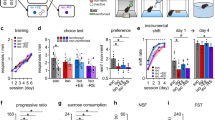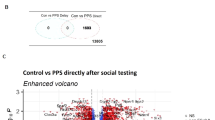Abstract
Social experiences during youth are thought to be critical for proper social and cognitive development. Conversely, social insults during development can cause long-lasting behavioral impairments and increase the vulnerability for psychopathology later in life. To investigate the importance of social experience during the juvenile and early adolescent stage for the development of cognitive control capacities, rats were socially isolated from postnatal day 21 to 42 followed by re-socialization until they reached adulthood. Subsequently, two behavioral dimensions of impulsivity (impulsive action in the five-choice serial reaction time task (5-CSRTT) and impulsive choice in the delayed reward task) and decision making (in the rat gambling task) were assessed. In a separate group of animals, long-lasting cellular and synaptic changes in adult medial prefrontal cortex (PFC) pyramidal neurons were determined following social isolation. Juvenile and early adolescent social isolation resulted in impairments in impulsive action and decision making under novel or challenging circumstances. Moreover, socially isolated rats had a reduced response to enhancement of dopaminergic neurotransmission (using amphetamine or GBR12909) in the 5-CSRTT under challenging conditions. Impulsive choice was not affected by social isolation. These behavioral deficits were accompanied by a loss of sensitivity to dopamine of pyramidal neurons in the medial PFC. Our data show long-lasting deleterious effects of early social isolation on cognitive control and its neural substrates. Alterations in prefrontal cognitive control mechanisms may contribute to the enhanced risk for psychiatric disorders induced by aberrations in the early social environment.
Similar content being viewed by others
Log in or create a free account to read this content
Gain free access to this article, as well as selected content from this journal and more on nature.com
or
References
Andersen SL (2003). Trajectories of brain development: point of vulnerability or window of opportunity? Neurosci Biobehav Rev 27: 3–18.
Baarendse PJJ, Vanderschuren LJMJ (2012). Dissociable effects of monoamine reuptake inhibitors on distinct forms of impulsive behavior in rats. Psychopharmacology 219: 313–326.
Baarendse PJJ, Winstanley CA, Vanderschuren LJMJ (2013). Simultaneous blockade of dopamine and noradrenaline reuptake promotes disadvantageous decision making in a rat gambling task. Psychopharmacology 225: 719–731.
Bechara A, Damasio AR, Damasio H, Anderson SW (1994). Insensitivity to future consequences following damage to human prefrontal cortex. Cognition 50: 7–15.
Blakemore SJ (2008). The social brain in adolescence. Nat Rev Neurosci 9: 267–277.
Brenhouse HC, Sonntag KC, Andersen SL (2008). Transient D1 dopamine receptor expression on prefrontal cortex projection neurons: relationship to enhanced motivational salience of drug cues in adolescence. J Neurosci 28: 2375–2382.
Cacioppo JT, Hawkley LC (2009). Perceived social isolation and cognition. Trends Cogn Sci 13: 447–454.
Casey BJ, Tottenham N, Liston C, Durston S (2005). Imaging the developing brain: what have we learned about cognitive development? Trends Cogn Sci 9: 104–110.
Chamberlain SR, Sahakian BJ (2007). The neuropsychiatry of impulsivity. Curr Opin Psychiatry 20: 255–261.
Cole BJ, Robbins TW (1989). Effects of 6-hydroxydopamine lesions of the nucleus accumbens septi on performance of a 5-choice serial reaction time task in rats: implications for theories of selective attention and arousal. Behav Brain Res 33: 165–179.
Counotte DS, Li KW, Wortel J, Gouwenberg Y, Van Der Schors RC, Smit AB et al (2010). Changes in molecular composition of rat medial prefrontal cortex synapses during adolescent development. Eur J Neurosci 32: 1452–1460.
Dalley JW, Theobald DE, Eagle DM, Passetti F, Robbins TW (2002b). Deficits in impulse control associated with tonically-elevated serotonergic function in rat prefrontal cortex. Neuropsychopharmacology 26: 716–728.
Dalley JW, Theobald DE, Pereira EA, Li PM, Robbins TW (2002a). Specific abnormalities in serotonin release in the prefrontal cortex of isolation-reared rats measured during behavioural performance of a task assessing visuospatial attention and impulsivity. Psychopharmacology 164: 329–340.
Eagle DM, Baunez C (2010). Is there an inhibitory-response-control system in the rat? Evidence from anatomical and pharmacological studies of behavioral inhibition. Neurosci Biobehav Rev 34: 50–72.
Economidou D, Theobald DE, Robbins TW, Everitt BJ, Dalley JW (2012). Norepinephrine and dopamine modulate impulsivity on the five-choice serial reaction time task through opponent actions in the shell and core sub-regions of the nucleus accumbens. Neuropsychopharmacology 37: 2057–2066.
Evenden JL, Ryan CN (1996). The pharmacology of impulsive behaviour in rats: the effects of drugs on response choice with varying delays of reinforcement. Psychopharmacology 128: 161–170.
Fone KC, Porkess MV (2008). Behavioural and neurochemical effects of post-weaning social isolation in rodents-relevance to developmental neuropsychiatric disorders. Neurosci Biobehav Rev 32: 1087–1102.
Kalsbeek A, Voorn P, Buijs RM, Pool CW, Uylings HB (1988). Development of the dopaminergic innervation in the prefrontal cortex of the rat. J Comp Neurol 269: 58–72.
Leussis MP, Lawson K, Stone K, Andersen SL (2008). The enduring effects of an adolescent social stressor on synaptic density, part II: Poststress reversal of synaptic loss in the cortex by adinazolam and MK-801. Synapse 62: 185–192.
Lichtman JW, Colman H (2000). Synapse elimination and indelible memory. Neuron 25: 269–278.
Louilot A, Le Moal M, Simon H (1989). Opposite influences of dopaminergic pathways to the prefrontal cortex or the septum on the dopaminergic transmission in the nucleus accumbens. An in vivo voltammetric study. Neuroscience 29: 45–56.
Lukkes J, Vuong S, Scholl J, Oliver H, Forster G (2009). Corticotropin-releasing factor receptor antagonism within the dorsal raphe nucleus reduces social anxiety-like behavior after early-life social isolation. J Neurosci 29: 9955–9960.
Makinodan M, Rosen KM, Ito S, Corfas G (2012). A critical period for social experience-dependent oligodendrocyte maturation and myelination. Science 337: 1357–1360.
McCutcheon JE, Marinelli M (2009). Age matters. Eur J Neurosci 29: 997–1014.
Miller EK, Cohen JD (2001). An integrative theory of prefrontal cortex function. Annu Rev Neurosci 24: 167–202.
Mitchell JB, Gratton A (1992). Partial dopamine depletion of the prefrontal cortex leads to enhanced mesolimbic dopamine release elicited by repeated exposure to naturally reinforcing stimuli. J Neurosci 12: 3609–3618.
Moeller FG, Barratt ES, Dougherty DM, Schmitz JM, Swann AC (2001). Psychiatric aspects of impulsivity. Am J Psychiatry 158: 1783–1793.
Nelson EE, Leibenluft E, McClure EB, Pine DS (2005). The social re-orientation of adolescence: a neuroscience perspective on the process and its relation to psychopathology. Psychol Med 35: 163–174.
Panksepp J (1981). The ontogeny of play in rats. Dev Psychobiol 14: 327–332.
Pattij T, Janssen MCW, Vanderschuren LJMJ, Schoffelmeer ANM, van Gaalen MM (2007). Involvement of dopamine D1 and D2 receptors in the nucleus accumbens core and shell in inhibitory response control. Psychopharmacology 191: 587–598.
Pattij T, Vanderschuren LJMJ (2008). The neuropharmacology of impulsive behaviour. Trends Pharmacol Sci 29: 192–199.
Paus T, Keshavan M, Giedd JN (2008). Why do many psychiatric disorders emerge during adolescence? Nat Rev Neurosci 9: 947–957.
Pellis SM, Pellis V (2009) The playful brain: venturing to the limits of neuroscience. Oneworld Publications: Oxford, UK.
Robbins TW (2002). The 5-choice serial reaction time task: behavioural pharmacology and functional neurochemistry. Psychopharmacology 163: 362–380.
Robbins TW, Arnsten AFT (2009). The neuropsychopharmacology of fronto-executive function: monoaminergic modulation. Annu Rev Neurosci 32: 267–287.
Seamans JK, Yang CR (2004). The principal features and mechanisms of dopamine modulation in the prefrontal cortex. Prog Neurobiol 74: 1–58.
Spear LP (2000). The adolescent brain and age-related behavioral manifestations. Neurosci Biobehav Rev 24: 417–463.
Špinka M, Newberry RC, Bekoff M (2001). Mammalian play: training for the unexpected. Q Rev Biol 76: 141–168.
Torregrossa MM, Xie M, Taylor JR (2012). Chronic corticosterone exposure during adolescence reduces impulsive action but increases impulsive choice and sensitivity to yohimbine in male Sprague-Dawley rats. Neuropsychopharmacology 37: 1656–1670.
Trezza V, Baarendse PJJ, Vanderschuren LJMJ (2010). The pleasures of play: pharmacological insights into social reward mechanisms. Trends Pharmacol Sci 31: 463–469.
Tseng KY, Lewis BL, Hashimoto T, Sesack SR, Kloc M, Lewis DA et al (2008). A neonatal ventral hippocampal lesion causes functional deficits in adult prefrontal cortical interneurons. J Neurosci 26: 12691–12699.
Tseng KY, O’Donnell P (2005). Post-pubertal emergence of prefrontal cortical oscillations induced by D1-NMDA co-activation. Cerebral Cortex 15: 49–57.
Tseng KY, O'Donnell P (2007). Dopamine modulation of prefrontal cortical interneurons changes during adolescence. Cerebral Cortex 17: 1235–1240.
Van den Berg CL, Hol T, Van Ree JM, Spruijt BM, Everts H, Koolhaas JM (1999). Play is indispensable for an adequate development of coping with social challenges in the rat. Dev Psychobiol 34: 129–138.
Van Gaalen MM, Brueggeman RJ, Bronius PFC, Schoffelmeer ANM, Vanderschuren LJMJ (2006a). Behavioral disinhibition requires dopamine receptor activation. Psychopharmacology 187: 73–85.
Van Gaalen MM, van Koten R, Schoffelmeer ANM, Vanderschuren LJMJ (2006b). Critical involvement of dopaminergic neurotransmission in impulsive decision making. Biol Psychiatry 60: 66–73.
Vanderschuren LJMJ, Niesink RJM, Van Ree JM (1997). The neurobiology of social play behavior in rats. Neurosci Biobehav Rev 21: 309–326.
Zeeb FD, Robbins TW, Winstanley CA (2009). Serotonergic and dopaminergic modulation of gambling behavior as assessed using a novel rat gambling task. Neuropsychopharmacology 34: 2329–2343.
Acknowledgements
This study was supported by National Institute on Drug Abuse Grants R01 DA022628 (L.J.M.J.V.) and R01 DA014020 (P.O’D).
Author information
Authors and Affiliations
Corresponding author
Ethics declarations
Competing interests
The authors declare no conflict of intertest.
Rights and permissions
About this article
Cite this article
Baarendse, P., Counotte, D., O'Donnell, P. et al. Early Social Experience Is Critical for the Development of Cognitive Control and Dopamine Modulation of Prefrontal Cortex Function. Neuropsychopharmacol 38, 1485–1494 (2013). https://doi.org/10.1038/npp.2013.47
Received:
Revised:
Accepted:
Published:
Issue date:
DOI: https://doi.org/10.1038/npp.2013.47
Keywords
This article is cited by
-
Effects of reduced kinematic and social play experience on affective appraisal of human-rat play in rats
Frontiers in Zoology (2023)
-
Early life social complexity shapes adult neural processing in the communal spiny mouse Acomys cahirinus
Psychopharmacology (2023)
-
Noradrenergic modulation of play in Sprague-Dawley and F344 rats
Psychopharmacology (2023)
-
Amphetamine disrupts dopamine axon growth in adolescence by a sex-specific mechanism in mice
Nature Communications (2023)
-
Regulation of oxytocin receptor gene expression in obsessive–compulsive disorder: a possible role for the microbiota-host epigenetic axis
Clinical Epigenetics (2022)



